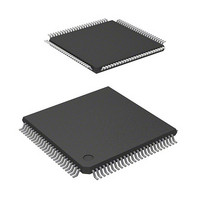DF2148RTE20IV Renesas Electronics America, DF2148RTE20IV Datasheet - Page 577

DF2148RTE20IV
Manufacturer Part Number
DF2148RTE20IV
Description
MCU 5V 128K I-TEMP,PB-FREE, 100-
Manufacturer
Renesas Electronics America
Series
H8® H8S/2100r
Specifications of DF2148RTE20IV
Core Processor
H8S/2000
Core Size
16-Bit
Speed
20MHz
Connectivity
Host Interface, I²C, IrDA, SCI
Peripherals
POR, PWM, WDT
Number Of I /o
74
Program Memory Size
128KB (128K x 8)
Program Memory Type
FLASH
Ram Size
4K x 8
Voltage - Supply (vcc/vdd)
4 V ~ 5.5 V
Data Converters
A/D 8x10b; D/A 2x8b
Oscillator Type
Internal
Operating Temperature
-40°C ~ 85°C
Package / Case
100-TQFP, 100-VQFP
Lead Free Status / RoHS Status
Lead free / RoHS Compliant
Eeprom Size
-
- Current page: 577 of 1179
- Download datasheet (7Mb)
16.3.5
In slave transmit mode, the slave device outputs the transmit data, while the master device outputs
the receive clock and returns an acknowledge signal. The transmission procedure and operations in
slave transmit mode are described below.
[1] Set the ICE bit in ICCR to 1. Set the MLS bit in ICMR and the MST and TRS bits in ICCR
[2] When the slave address matches in the first frame following detection of the start condition,
[3] After clearing the IRIC flag to 0, write data to ICDR. The TDRE internal flag is cleared to 0.
[4] When one frame of data has been transmitted, the IRIC flag in ICCR is set to 1 at the rise of
[5] To continue transmission, clear the IRIC flag to 0, then write the next data to be transmitted
Transmit operations can be performed continuously by repeating steps [4] and [5]. To end
transmission, write H'FF to ICDR to release SDA on the slave side. When SDA is changed from
low to high when SCL is high, and the stop condition is detected, the BBSY flag in ICCR is
cleared to 0.
according to the operating mode.
the slave device drives SDA low at the 9th clock pulse and returns an acknowledge signal. At
the same time, the IRIC flag in ICCR is set to 1. If the IEIC bit in ICCR has been set to 1, an
interrupt request is sent to the CPU. If the 8th data bit (R/W) is 1, the TRS bit in ICCR is set to
1, and the mode changes to slave transmit mode automatically. The TDRE internal flag is set
to 1. The slave device drives SCL low from the fall of the transmit clock until ICDR data is
written.
The written data is transferred to ICDRS, and the TDRE internal flag and the IRIC and IRTR
flags are set to 1 again. After clearing the IRIC flag to 0, write the next data to ICDR. The
slave device sequentially sends the data written into ICDR in accordance with the clock output
by the master device at the timing shown in figure 16.11.
the 9th transmit clock pulse. If the TDRE internal flag has been set to 1, this slave device
drives SCL low from the fall of the transmit clock until data is written to ICDR. The master
device drives SDA low at the 9th clock pulse, and returns an acknowledge signal. As this
acknowledge signal is stored in the ACKB bit in ICSR, this bit can be used to determine
whether the transfer operation was performed normally. When the TDRE internal flag is 0, the
data written into ICDR is transferred to ICDRS, transmission is started, and the TDRE internal
flag and the IRIC and IRTR flags are set to 1 again.
into ICDR. The TDRE internal flag is cleared to 0.
Slave Transmit Operation
Rev. 4.00 Sep 27, 2006 page 531 of 1130
Section 16 I
2
C Bus Interface [Option]
REJ09B0327-0400
Related parts for DF2148RTE20IV
Image
Part Number
Description
Manufacturer
Datasheet
Request
R

Part Number:
Description:
KIT STARTER FOR M16C/29
Manufacturer:
Renesas Electronics America
Datasheet:

Part Number:
Description:
KIT STARTER FOR R8C/2D
Manufacturer:
Renesas Electronics America
Datasheet:

Part Number:
Description:
R0K33062P STARTER KIT
Manufacturer:
Renesas Electronics America
Datasheet:

Part Number:
Description:
KIT STARTER FOR R8C/23 E8A
Manufacturer:
Renesas Electronics America
Datasheet:

Part Number:
Description:
KIT STARTER FOR R8C/25
Manufacturer:
Renesas Electronics America
Datasheet:

Part Number:
Description:
KIT STARTER H8S2456 SHARPE DSPLY
Manufacturer:
Renesas Electronics America
Datasheet:

Part Number:
Description:
KIT STARTER FOR R8C38C
Manufacturer:
Renesas Electronics America
Datasheet:

Part Number:
Description:
KIT STARTER FOR R8C35C
Manufacturer:
Renesas Electronics America
Datasheet:

Part Number:
Description:
KIT STARTER FOR R8CL3AC+LCD APPS
Manufacturer:
Renesas Electronics America
Datasheet:

Part Number:
Description:
KIT STARTER FOR RX610
Manufacturer:
Renesas Electronics America
Datasheet:

Part Number:
Description:
KIT STARTER FOR R32C/118
Manufacturer:
Renesas Electronics America
Datasheet:

Part Number:
Description:
KIT DEV RSK-R8C/26-29
Manufacturer:
Renesas Electronics America
Datasheet:

Part Number:
Description:
KIT STARTER FOR SH7124
Manufacturer:
Renesas Electronics America
Datasheet:

Part Number:
Description:
KIT STARTER FOR H8SX/1622
Manufacturer:
Renesas Electronics America
Datasheet:

Part Number:
Description:
KIT DEV FOR SH7203
Manufacturer:
Renesas Electronics America
Datasheet:










